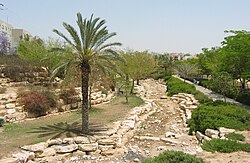Wadi is the Arabic term traditionally referring to a valley. In some cases, it may refer to a dry (ephemeral) riverbed that contains water only during times of heavy rain or simply an intermittent stream.
Modern English usage differentiates a wadi from another canyon or wash
by the action and prevalence of water. Wadis, as drainage courses, are
formed by water, but are distinguished from river valleys or gullies in
that surface water is intermittent or ephemeral. Wadis, cut by stream in a desert
environment, generally are dry year round except after a rain. The
desert environment is characterized by a sudden but infrequent heavy
rainfall often resulting in flash floods. Crossing wadis at certain times of the year can be dangerous because of unexpected flash floods. Such flash floods cause several deaths each year in North America and many Middle Eastern countries.
Wadis tend to be associated with centers of human population because
sub-surface water is sometimes available in them. Nomadic and pastoral
desert peoples will rely on seasonal vegetation found in wadis, even in
regions as dry as the Sahara, as they travel in complex transhumance routes.
Subscribe to:
Post Comments (Atom)




No comments:
Post a Comment